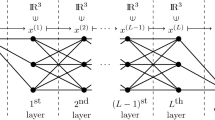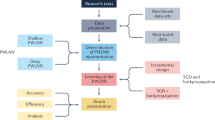Abstract
Although many artificial neural networks have achieved success in practical applications, there is still a concern among many over their “black box” nature. Why and how do they work? Recently, some interesting interpretations have been made through polynomial regression as an alternative to neural networks. Polynomial networks have thus received more and more attention as generators of polynomial regression. Furthermore, some special polynomial works, such as dendrite net (DD) and Kileel et al.’s deep polynomial neural networks, showed that some single neurons have powerful computability. This agrees with a recent discovery on biological neurons, that is, a single biological neuron can perform XOR operations. Inspired by such works, we propose a new model called the polynomial dendritic neural network (PDN) in this article. The PDN achieves powerful computability on a single neuron in a neural network. The output of a PDN is a high degree polynomial of the inputs. To obtain its parameter values, we took PDN as a neural network and employed the back-propagation method. As shown in this context, PDN contains more polynomial outputs than DD and deep polynomial neural networks. We deliberately studied two special PDNs called the exponential PDN (EPDN) and asymptotic PDN (APDN). For interpretability, we proposed a feature analysis method based on the coefficients of the polynomial outputs of such PDNs. The EPDN and APDN showed satisfactory accuracy, precision, recall, F1 score, and AUC in several experiments. Furthermore, we found the coefficient-based interpretability to be effective on some actual health cases.












Similar content being viewed by others
References
Abdelouahab K, Pelcat M, Berry F (2017) Why tanh can be a hardware friendly activation function for CNNs. In: Proceedings of the 11th international conference on distributed smart cameras, pp 199–201
Adebayo J, Gilmer J, Muelly M, Goodfellow I, Hardt M, Kim B (2018) Sanity checks for saliency maps. In: Proceedings of the 32nd international conference on neural information processing systems, NeurIPS’18, pp 9525–9536
Bahdanau D, Cho K, Bengio Y (2015) Neural machine translation by jointly learning to align and translate. ICLR
Bowman S, Angeli G, Potts C, Manning C (2015) A large annotated corpus for learning natural language inference. In: Proceedings of the 2015 conference on empirical methods in natural language processing, pp 632–642
Chen X, Duan Y, Houthooft R, Schulman J, Sutskever I, Abbeel P (2016) Infogan: interpretable representation learning by information maximizing generative adversarial nets. In: Proceedings of the 30th international conference on neural information processing systems, pp 2180–2188
Dahl G, Yu D, Deng L, Acero A (2011) Context-dependent pre-trained deep neural networks forlarge-vocabulary speech recognition. IEEE Trans Audio Speech Lang Proces 20(1):30–42
Dong Y, Hang S, Zhu J, Bo Z (2017) Improving interpretability of deep neural networks with semantic information. In: Proceedings of the IEEE conference on computer vision and pattern recognition, pp 4306–4314
Emschwiller M, Gamarnik D, Kızıldaǧ E, Zadik I (2020) Neural networks and polynomial regression. Demystifying the overparametrizaiotn phenomena. arXiv preprint arXiv:2003.10523
Ghorbani A, Abid A, Zou J (2019) Interpretation of neural networks is fragile. In: Proceedings of the AAAI conference on artificial intelligence, vol 33, issue no 1, pp 3681–3688
Gidon A, Zolnik TA, Fidzinski P, Bolduan F, Larkum M (2020) Dendritic action potentials and computation in human layer 2/3 cortical neurons. Science 367(6473):83–87
Goodfellow I, Bengio Y, Courville A (2016) Deep learning. MIT press (2016)
Guidotti R, Monreale A, Ruggieri S, Turini F, Giannotti F, Pedreschi D (2018) A survey of methods for explaining black box models. ACM Comput Surv 51(5):1–42
He K, Zhang X, Ren S, Sun J (2015) Delving deep into rectifiers: Surpassing human-level performance on imagenet classification. In: Proceedings of the IEEE international conference on computer vision, pp 1026–1034
Higgins I, Matthey L, Pal A, Burgess C, Glorot X, Botvinick M, Mohamed S, Lerchner A (2017) beta-vae: Learning basic visual concepts with a constrained variational framework. In: 5th International conference on learning representations, conference track proceedings
Huang W, Oh S, Pedrycz W (2014) Design of hybrid radial basis function neural networks (HRBFNNs) realized with the aid of hybridization of fuzzy clustering method (FCM) and polynomial neural networks (PNNs). Neural Netw 60:166–181
Huang G, Liu Z, Laurens V, Weinberger K (2017) Densely connected convolutional networks. In: Proceedings of the IEEE conference on computer vision and pattern recognition, pp 4700–4708
Hui Z, Zhu J, Rosset S, Hastie T (2009) Multi-class adaboost. Stat. Interface 2(3):349–360
Hyvarinen A, Oja E (2000) Independent component analysis: algorithms and applications. Neural Netw 13(4):411–430
Kileel J, Trager M, Bruna J (2019) On the expressive power of deep polynomial neural networks. Adv Neural Inf Process Syst 32:10310–10319
Kingma D, Ba J (2014) Adam: a method for stochastic optimization. arXiv preprint arXiv:1412.6980
Kingma D, Welling M (2013) Auto-encoding variational bayes, 2013. arXiv preprint arXiv:1312.6114
Klambauer G, Unterthiner T, Mayr A, Hochreiter S (2017) Self-normalizing neural networks. In: Proceedings of the 31st international conference on neural information processing systems, pp 972–981
Kramer O (2016) Machine learning for evolution strategies, vol 20. Springer, Switzerland
Liu G, Wang J (2021) Dendrite net: a white-box module for classification, regression, and system identification. IEEE Trans Cybern 1–14
Luxburg U (2004) A tutorial on spectral clustering. Stat Comput 17(4):395–416
Menon A, Mehrotra K, Mohan C, Ranka S (1996) Characterization of a class of sigmoid functions with applications to neural networks. Neural Netw 9(5):819–835
Park C, Choi E, Han K, Lee H, Rhee T, Lee S, Cha M, Lim W, Kang S, Oh S (2017) Association between adult height, myocardial infarction, heart failure, stroke and death: a Korean nationwide population-based study. Int J Epidemiol 47(1):289–298
Safavian S, Landgrebe D (1991) A survey of decision tree classifier methodology. IEEE Trans Syst Man Cybern 21(3):660–674
Sainath T, Vinyals O, Senior A, Sak H (2015) Convolutional, long short-term memory, fully connected deep neural networks. In: 2015 IEEE international conference on acoustics, speech and signal processing (ICASSP), pp 4580–4584
Selvaraju R, Cogswell M, Das A, Vedantam R, Parikh D, Batra D (2017) Grad-cam: visual explanations from deep networks via gradient-based localization. In: Proceedings of the IEEE international conference on computer vision, pp 618–626
Simonyan K, Vedaldi A, Zisserman A (2014) Deep inside convolutional networks: Visualising image classification models and saliency maps. In: Workshop at international conference on learning representations
Springenberg J, Dosovitskiy A, Brox T, Riedmiller M (2014) Striving for simplicity: The all convolutional net. arXiv preprint arXiv:1412.6806
Sundararajan M, Taly A, Yan Q (2016) Gradients of counterfactuals. arXiv preprint arXiv:1611.02639
Sweller J (1988) Cognitive load during problem solving: effects on learning. Cogn Sci 12(2):257–285
Vaswani A, Shazeer N, Parmar N, Uszkoreit J, Jones L, Gomez A, Kaiser Ł, Polosukhin I (2017) Attention is all you need. In: Advances in neural information processing systems, pp 5998–6008
Veličković P, Cucurull G, Casanova A, Romero A, Liò P, Bengio Y (2018) Graph attention networks. In: International conference on learning representations
Wold S, Esbensen K, Geladi P (1987) Principal component analysis. Chemom Intell Lab Syst 2(1–3):37–52
Xi C, Khomtchouk B, Matloff N, Mohanty P (2018) Polynomial regression as an alternative to neural nets. arXiv preprint arXiv:1806.06850
Yang S, Ho C, Lee C (2006) HBP: improvement in BP algorithm for an adaptive MLP decision feedback equalizer. IEEE Trans Circuits Syst II Express Briefs 53(3):240–244
Zeiler M, Fergus R (2014) Visualizing and understanding convolutional networks. In: European conference on computer vision, pp 818–833
Zjavka L, Pedrycz W (2016) Constructing general partial differential equations using polynomial and neural networks. Neural Netw 73:58–69
Acknowledgements
The authors are grateful to Professors Peng Tang and Bin Yi, in Southwest Hospital, Third Military Medical University, for their professional explanations for the breast cancer and cardiovascular disease results.
Author information
Authors and Affiliations
Corresponding author
Ethics declarations
Conflict of interest
The authors declare that they have no conflict of interest.
Additional information
Publisher's Note
Springer Nature remains neutral with regard to jurisdictional claims in published maps and institutional affiliations.
This work was partially supported by the National Key R&D Program of China (No. 2018YFC0116704), NSF of China (No. 61672488), Science and Technology Service Network Initiative (No. KFJ-STS-QYZD-2021-01-001), Youth Innovation Promotion Association of Chinese Academy of Sciences (No. 2020377).
Rights and permissions
About this article
Cite this article
Chen, Y., Liu, J. Polynomial dendritic neural networks. Neural Comput & Applic 34, 11571–11588 (2022). https://doi.org/10.1007/s00521-022-07044-4
Received:
Accepted:
Published:
Issue Date:
DOI: https://doi.org/10.1007/s00521-022-07044-4




